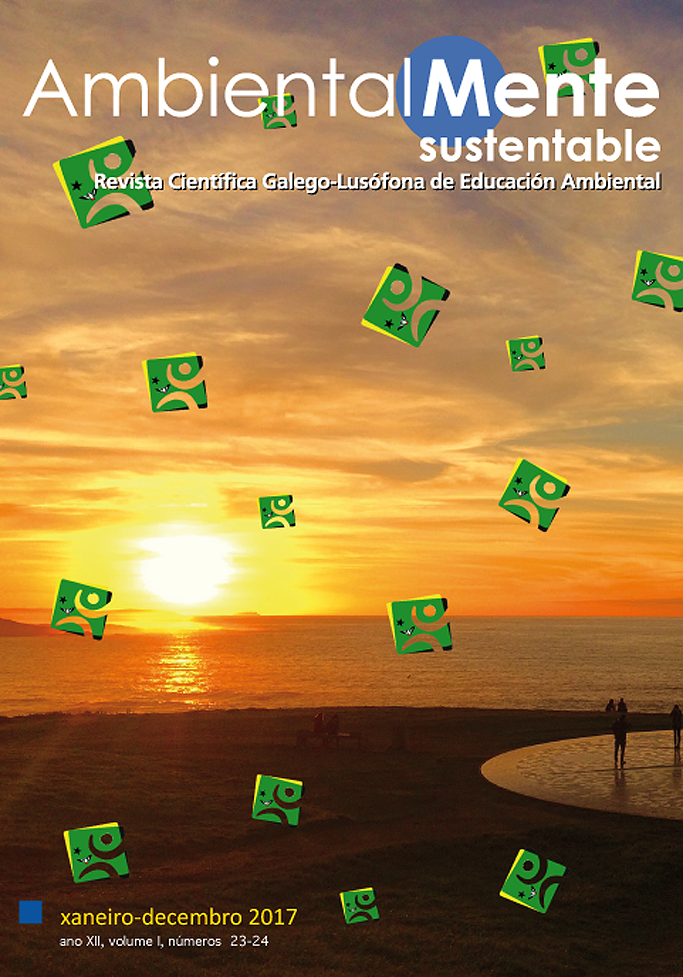A educação ambiental e a valorização do património natural de São Tomé e Príncipe: contributos e desafios para o desenvolvimento local
DOI:
https://doi.org/10.17979/ams.2017.23-24.1.3386Palavras-chave:
educação ambiental, património natural, biodiversidade, geodiversidade, rede de geossitios de São Tomé e PríncipeResumo
O património natural de São Tomé e Príncipe tem vindo a ser identificado e reconhecido pela comunidade científica, processo em que se tem destacado mais a sua riquíssima diversidade biológica que a geológica, não obstante a sua relativa importância. O relacionamento da comunidade com os recursos naturais do arquipélago tem vindo a intensificar-se e a promover impactos significativos, como o atestam a progressiva depleção da floresta, a erosão costeira e a extração furtiva de inertes, entre outras situações identificadas. Promover um maior e melhor conhecimento do património natural de São Tomé e Príncipe, bem como de modelos de relacionamento mais harmoniosos entre a comunidade e este património, é um desígnio da Educação Ambiental. A Educação Ambiental torna-se promotora da sensibilização, formação, divulgação, promoção e valorização do conhecimento relativo ao património natural/ambiental, tornando-se um veículo de intervenção e desenvolvimento comunitário. Pode contribuir, assim, para o desenvolvimento do arquipélago aos seus vários níveis -abarcando múltiplos atores nesse processo educativo, nomeadamente estabelecimentos de ensino, organizações não-governamentais com preocupações ambientais e de desenvolvimento, ordens profissionais e poder político, entre outros– exigindo também o estabelecimento de uma rede de cooperação/parcerias essencial ao país e à defesa do seu património natural.
Downloads
Referências
Brilha, J.; Pereira, P.; Pereira, D.; Hemnriques, R. (2013): Geossítios de Relevância nacional e Internacional em Portugal Continental (pp. 169-176). In Magalhães, M. R. (Coord.) (2013). Estrutura Ecológica nacional – Uma proposta de delimitação e regulamentação. Lisboa, ISAPress.
Cardoso, J. C.; Garcia, J.S. (1962): Carta dos solos de São Tomé e Príncipe. Lisboa: Memórias da Junta de Investigações do Ultramar, segunda série, nº 39.
Gonçalves, F. (2010): Os Cetáceos em São Tomé e Príncipe: A luta pela Biodiversidade e Dignidade de um Povo (pp.122-138). in Brito, B. (Coord.) (2010). Abrindo trilhos tecendo redes – reflexões e experiências de desenvolvimento local em contexto lusófono. Lisboa, Gerpress.
Gonçalves, F.; Pereira, R.; Azeiteiro, M.M.U.; Pereira, M.J.V. (2007): Actividades práticas em Ciência e Educação Ambiental. Lisboa, Instituto Piaget.
Leventis. A.P.; Olmos, F. (2009): As Aves de São Tomé e Príncipe: um guia fotográfico / The Birds of São Tomé e Príncipe: a photoguide (bilingue). 1ª ed. S. Paulo, Brasil, Alves & Fotos Editora.
Lima, R.F. (2012): Alterações do uso do solo e biodiversidade em São Tomé. in Actas do Colóquio Internacional São Tomé e Príncipe numa perspectiva interdisciplinar, diacrónica e sincrónica (pp. 455-464). Lisboa: Instituto Universitário de Lisboa (ISCTE-IUL), Centro de Estudos Africanos e Instituto de Investigação Científica Tropical (IICT).
MARAPA. (2009): Ecologia e Educação Ambiental em S. Tomé e Príncipe. S. Tomé e Príncipe: MARAPA; CTA.
Mendes, L.F.; Sousa, A. B. (2012): Riqueza de espécies e endemicidade das borboletas diurnas (Lepidoptera: Rhopalocera) de São Tomé e Príncipe (pp. 653-663). in Actas do Colóquio Internacional São Tomé e Príncipe numa perspectiva interdisciplinar, diacrónica e sincrónica. Lisboa: Instituto Universitário de Lisboa (ISCTE-IUL), Centro de Estudos Africanos e Instituto de Investigação Científica Tropical (IICT).
Munhá, J.; Caldeira, R.; Madeira, J.; Mata, J.; Afonso, R. (2007): Geologia da ilha de S. Tomé. Notícia explicativa da carta geológica na escala 1:25000. Lisboa, Cooperação portuguesa e IPAD – Instituto Português de Apoio ao Desenvolvimento.
Nascimento, M.A.L.; Mantesso-Neto, V.; Ruchkys, U.A. (2008): Geodiversidade, geoconservação e geoturismo: trinômio importante para a proteção do patrimônio geológico. São Paulo, SBG.
Oliveira, M.; Santos, O. (2013): Património Natural de São Tomé e Príncipe – Conhecer para Preservar. Ed. Instituto Marquês de Valle Flôr (Edição digital: http://imvf.org/ficheiros/file/brochurapatrimonionatural.pdf).
Pinto, J.R.; Lima, J.P. (Coord) (2014): Manual de Educação Ambiental - São Tomé e Príncipe - Ecossistemas, impactes ambientais e gestão responsável dos recursos naturais. São Tomé e Príncipe, MARAPA/ASPEA.
Downloads
Publicado
Edição
Secção
Licença
Os traballos publicados nesta revista están baixo unha licenza Creative Commons Recoñecemento-CompartirIgual 4.0 Internacional.
Permitese e anímase aos autores a difundir os artigos aceptados para a súa publicación nos sitios web persoais ou institucionais, antes e despois da súa publicación, sempre que se indique claramente que o traballo pertence a esta revista e se proporcionen os datos bibliográficos completos xunto co acceso ao documento.



